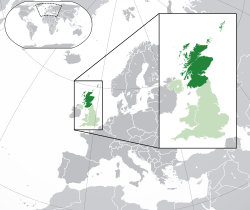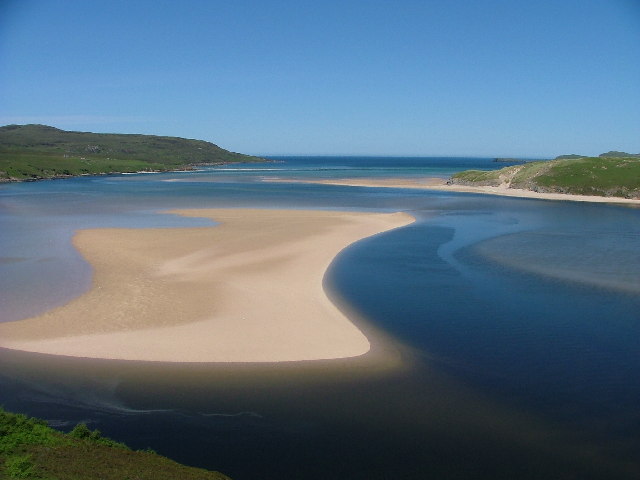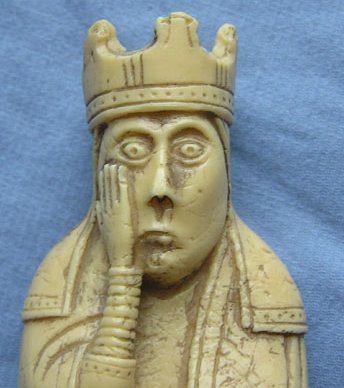Portal:Scotland
| Main Page | Selected articles 1 | Selected articles 2 | Selected biographies | Selected quotes | Selected pictures | Featured Content | Categories & Topics |
Introduction
 |

|
|

| ||
Scotland is a country that is part of the United Kingdom. It contains nearly one-third of the United Kingdom's land area, consisting of the northern part of the island of Great Britain and more than 790 adjacent islands, principally in the archipelagos of the Hebrides and the Northern Isles. In 2022, the country's population was about 5.4 million. Its capital city is Edinburgh, whilst Glasgow is the largest city and the most populous of the cities of Scotland. To the south-east, Scotland has its only land border, which is 96 miles (154 km) long and shared with England; the country is surrounded by the Atlantic Ocean to the north and west, the North Sea to the north-east and east, and the Irish Sea to the south. The legislature, the Scottish Parliament, elects 129 MSPs to represent 73 constituencies across the country. The Scottish Government is the executive arm of the devolved government, headed by the first minister who chairs the cabinet and responsible for government policy and international engagement.
The Kingdom of Scotland emerged as an independent sovereign state in the 9th century. In 1603, James VI succeeded to the thrones of England and Ireland, forming a personal union of the three kingdoms. On 1 May 1707, Scotland and England combined to create the new Kingdom of Great Britain, with the Parliament of Scotland subsumed into the Parliament of Great Britain. In 1999, a Scottish Parliament was re-established, and has devolved authority over many areas of domestic policy. The country has its own distinct legal system, education system and religious history, which have all contributed to the continuation of Scottish culture and national identity. Scottish English and Scots are the most widely spoken languages in the country, existing on a dialect continuum with each other. Scottish Gaelic speakers can be found all over Scotland, but the language is largely spoken natively by communities within the Hebrides; Gaelic speakers now constitute less than 2% of the total population, though state-sponsored revitalisation attempts have led to a growing community of second language speakers.
The mainland of Scotland is broadly divided into three regions: the Highlands, a mountainous region in the north and north-west; the Lowlands, a flatter plain across the centre of the country; and the Southern Uplands, a hilly region along the southern border. The Highlands are the most mountainous region of the British Isles and contain its highest peak, Ben Nevis, at 4,413 feet (1,345 m). The region also contains many lakes, called lochs; the term is also applied to the many saltwater inlets along the country's deeply indented western coastline. The geography of the many islands is varied. Some, such as Mull and Skye, are noted for their mountainous terrain, while the likes of Tiree and Coll are much flatter.
Selected article
The Most Ancient and Most Noble Order of the Thistle is an order of chivalry associated with Scotland. The current version of the order was founded in 1687 by King James VII of Scotland, who asserted that he was reviving an earlier order. The order consists of the sovereign and sixteen knights and ladies, as well as certain "extra" knights (members of the British royal family and foreign monarchs). The sovereign alone grants membership of the order; they are not advised by the government, as occurs with most other orders.
The order's primary emblem is the thistle, the national flower of Scotland. The motto is Nemo me impune lacessit (Latin for "No one provokes me with impunity"). The same motto appears on the Royal coat of arms of the United Kingdom for use in Scotland and pound coins minted in 1984, 1989, 1994, and 1999 (since withdrawn), and is also the motto of the Royal Scots Dragoon Guards, the Scots Guards, the Royal Regiment of Scotland, and the Black Watch (Royal Highland Regiment) of Canada. The patron saint of the order is St Andrew.
Most British orders of chivalry cover the whole United Kingdom, but the three most exalted ones each pertain to one constituent country only. The Order of the Thistle, which pertains to Scotland, is the second most senior in precedence. Its equivalent in England, the Most Noble Order of the Garter, is the oldest documented order of chivalry in the United Kingdom, dating to the middle fourteenth century. In 1783 an Irish equivalent, the Most Illustrious Order of St Patrick, was founded, but it is now dormant. (... Read the full article)
Selected quotes
In the news

- 24 May 2025 – 2024–25 Scottish Cup
- In association football, Aberdeen F.C. wins their 9th Scottish Cup and their first in 35 years after defeating 42-time winners Celtic F.C. 4–3 in the final on penalties after a 1–1 draw at Hampden Park in Glasgow. (BBC Sport)
Selected biography
Robert I (11 July 1274 – 7 June 1329), popularly known as Robert the Bruce (Scottish Gaelic: Raibeart am Brusach), was King of Scots from 1306 until his death in 1329. Robert led Scotland during the First War of Scottish Independence against England. He fought successfully during his reign to restore Scotland to an independent kingdom and is regarded in Scotland as a national hero.
Robert was a fourth-great-grandson of King David I, and his grandfather, Robert de Brus, 5th Lord of Annandale, was one of the claimants to the Scottish throne during the "Great Cause".
As Earl of Carrick, Robert the Bruce supported his family's claim to the Scottish throne and took part in William Wallace's campaign against Edward I of England. Appointed in 1298 as a Guardian of Scotland alongside his chief rival for the throne, John Comyn of Badenoch, and William Lamberton, Bishop of St Andrews, Robert resigned in 1300 because of his quarrels with Comyn and the apparently imminent restoration of John Balliol to the Scottish throne. After submitting to Edward I in 1302 and returning to "the king's peace", Robert inherited his family's claim to the Scottish throne upon his father's death.
Bruce's involvement in John Comyn's murder in February 1306 led to his excommunication by Pope Clement V (although he received absolution from Robert Wishart, Bishop of Glasgow). Bruce moved quickly to seize the throne and was crowned king of Scots on 25 March 1306. Edward I's forces defeated Robert in the Battle of Methven, forcing him to flee into hiding, before re-emerging in 1307 to defeat an English army at Loudoun Hill and wage a highly successful guerrilla war against the English. (... Read the full article)
Selected picture
Did You Know...

- ... that because of violent reactions – such as Jenny Geddes's on 23 July 1637 – to a Scottish prayer book, Walter Whitford kept loaded pistols visible to his congregants while using the book?
- ... that the New York Yankees were first named after a Scottish regiment?
- ... that the 1830 abandonment of Chipewyan woman Matooskie by her Scottish husband was eventually settled with a dowry payment of £200?
- ... that Colin Mackay, the political editor at Scottish Television, was "very sad" when Colin MacKay, the political editor at Scottish Television, died?
- ... that John Neilson, a Scottish immigrant to Lower Canada, became a major publisher and bookseller, and was reportedly "the largest consumer of paper" in the country?
- ... that former Scottish Conservative leader Ruth Davidson said that she would swim in Loch Ness naked if the SNP won more than 50 seats at the 2019 United Kingdom general election?
- ... that Scottish bricklayer Brian Higgins was unable to find work for 25 years after appearing on a construction-industry blacklist?
- ... that the Scottish surgeon John Blair was the only dux of his high school to receive his gold medal in the presence of his wife and child?
Get involved
For editor resources and to collaborate with other editors on improving Wikipedia's Scotland-related articles, see WikiProject Scotland.
To get involved in helping to improve Wikipedia's Scotland related content, please consider doing some of the following tasks or joining one or more of the associated Wikiprojects:
- Visit the Scottish Wikipedians' notice board and help to write new Scotland-related articles, and expand and improve existing ones.
- Visit Wikipedia:WikiProject Scotland/Assessment, and help out by assessing unrated Scottish articles.
- Add the Project Banner to Scottish articles around Wikipedia.
- Participate in WikiProject Scotland's Peer Review, including responding to PR requests and nominating Scottish articles.
- Help nominate and select new content for the Scotland portal.
Do you have a question about The Scotland Portal that you can't find the answer to?
Post a question on the Talk Page or consider asking it at the Wikipedia reference desk.
Related portals
Other language versions
Associated Wikimedia
The following Wikimedia Foundation sister projects provide more on this subject:
-
Commons
Free media repository -
Wikibooks
Free textbooks and manuals -
Wikidata
Free knowledge base -
Wikinews
Free-content news -
Wikiquote
Collection of quotations -
Wikisource
Free-content library -
Wikispecies
Directory of species -
Wikiversity
Free learning tools -
Wikivoyage
Free travel guide -
Wiktionary
Dictionary and thesaurus

























































